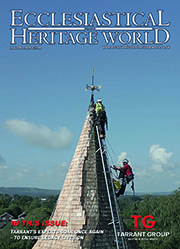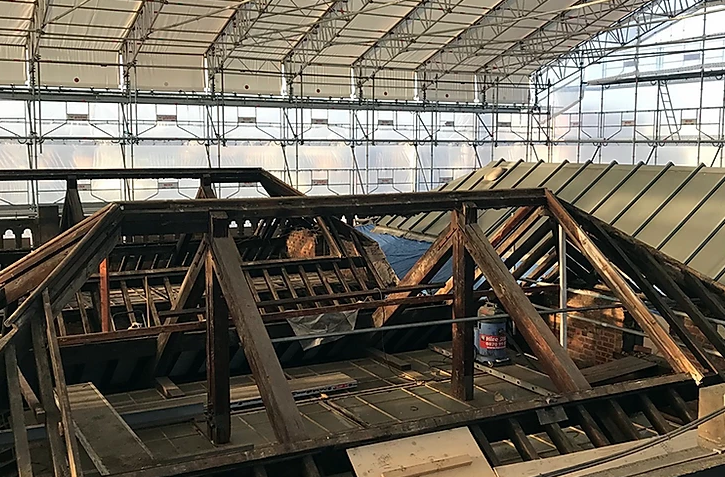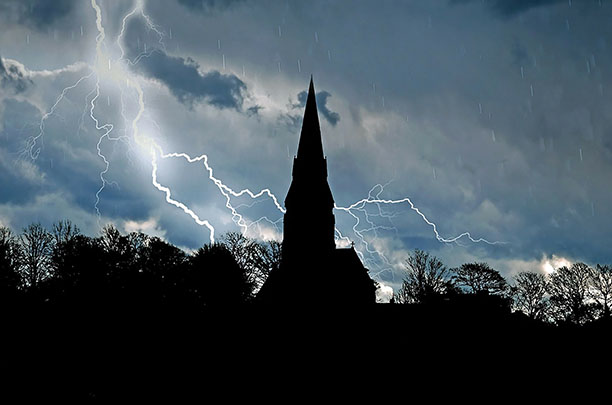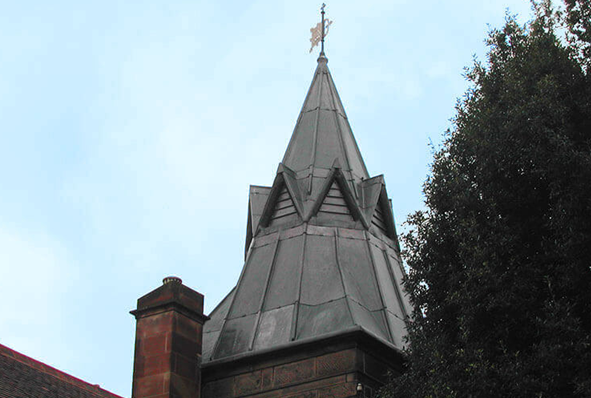Heritage Roofing
Heritage roofing - maintaining our iconic buildings
The UK is home to some of the most iconic buildings in the world, from stunning churches and cathedrals to historic stately homes. Each and every one of these remarkable feats of architecture requires regular maintenance to ensure they remain in the very best condition, allowing them to be enjoyed for generations.
Lightning Protection
When lightning strikes are you protected against this act of God?
The issue of lightning protection in churches is one that has exercised this publication for many years. In this four-part series of spotlights on the issue we will be revisiting various aspects of the subject, beginning with an overview of current thinking.
Traditional Lime
Lime: it’s better for buildings – and for the environment
It is now fairly well known that cement is not good for old buildings and that lime mortar should be used. But why? What are the advantages and what are the disadvantages? In order to begin to answer those questions it is necessary to understand the nature of traditional building, the process by which buildings used to be built, and how it differs from modern construction, the process by which we build today.
Audio Visual
Audio visual equipment in church buildings
This guidance is issued by the Church Buildings Council under section 55(1)(d) of the Dioceses, Mission and Pastoral Measure 2007. As it is statutory guidance, it must be considered with great care. The standards of good practice set out in the guidance should not be departed from unless the departure is justified by reasons that are spelled out clearly, logically and convincingly.
Read More...
CRE Events
Churches are coming under starter’s orders for CRE 25
Churches across the nation are beginning to make preparations for their visit to Christian Resources Exhibition’s CRE 25.
Insurance
You need to ensure that reasonable precautions are in place at your church to keep it safe for those who use it. To do this, you need to think about what might cause harm to people.
You will then need to decide if the precautions already in place are adequate. If they are not, you may need to identify further action to prevent any danger. When done formally, this is known as a risk assessment.
LPOW Grants
£23 million government package to support restoration of thousands of listed places of worship
Heritage Minister Sir Chris Bryant has announced that the Listed Places of Worship Grant Scheme will be extended into the next financial year, providing £23 million so that thousands of historical buildings, including churches, synagogues, mosques and temples, can carry out restoration work.
Lead Roofing
Lead is one of the oldest materials in the roofing industry and is still commonly used throughout the world today.
Lead roofing is a traditional roofing method which has been used in the industry for hundreds of years, and is therefore proven to be extremely reliable. Lead roofing, and sand-cast lead, in particular is ideal for old buildings such as churches or historical renovations, whereas milled lead roofing is a mass-produced alternative, used for precision and accuracy in homes and commercial buildings alike.
Home
JOHN PIPER and the CHURCH
DORCHESTER ABBEY, OXFORDSHIRE
A celebration of HM The Queen’s Diamond Jubilee by The Friends of Dorchester Abbey
21st April to 10th June 2012
‘John Piper and the Church’, an important loan exhibition of paintings, stained glass and tapestry designs, drawings and ecclesiastical vestments, is to be held at Dorchester Abbey, Dorchester-on-Thames, Oxfordshire OX10 7HH from 21st April to 10th June 2012.
More than 50 works spanning Piper’s career will be shown along with key works from public collections including the Britten-Pears Foundation; Manchester City Art Gallery; Pallant House Gallery, Chichester; The Collection, Lincolnshire (Usher Gallery) and the V&A. The exhibition will also include special works from private collections, most of which have been rarely seen.
This special exhibition celebrates the contribution of one man, the artist John Piper (1903-1992) to the development of modern art in British churches throughout the 20th century. It will chart his life-long fascination with, and care for, church buildings – a relationship which began as a young boy when he produced his own sketches and guidebook to the churches in his home county of Surrey. His love of stained glass was ignited when, as a ten year-old, he experienced the ‘thrilling shock’ of ‘light coming through a maze of richly coloured glass, in general darkness’ when visiting Notre Dame (quotation from Foreword to Glass Light, 1978).
Examples of Piper’s early work include St Nicholas Church, Blakeney, 1921 drawn when he was 18 years old and a view of Netley Abbey recorded in an antiquarian style in 1922. Octagonal Church, Hartwell, Buckinghamshire, 1939 loaned by the Usher Gallery, Lincolnshire, is a wonderful example of Piper’s new romantic style of architectural painting as he emerged from a period of abstraction which had occupied him for most of the 1930s.
World War II had a profound effect on Piper and as an official War Artist he produced a collection of paintings of bomb-damaged churches and those in decay. A key painting which illustrates this period is Coventry Cathedral, November 15, 1940 loaned by Manchester City Art Gallery. At this time he was already engaged with Kenneth Clark’s Recording Britain project, which was intended to boost morale by celebrating the country’s natural beauty and architectural heritage as well as providing a visual record of significant landmarks perceived to be under threat of damage or destruction. A good example on loan from the V&A is Chancel Arch, St Peter’s Stanton Low, Buckinghamshire.
During the war, 283 churches of all denominations were lost and, owing to the scarcity of building materials, only 41 were consecrated in the period 1945 to 1956. This gave architects and artists the opportunity to bring 20th century art into churches and, as a result, Piper undertook a series of commissions to create modern stained glass windows, tapestries and vestments. Some of these were nationally known, such as the Baptistry Window at Coventry and the High Altar tapestry at Chichester. The exhibition is fortunate to include Sketch for Chichester Cathedral Tapestry, 1965 and Trial Panel for St Luke, 1965 loaned by Pallant House Gallery as well as Designs for Hereford Cathedral Tapestries, 1976, which have never been shown before.
In addition, the exhibition includes stained glass designs for the Oundle School Chapel windows, including what is thought to be the design for Piper’s first ever trial panel of stained glass, translated by Patrick Reyntiens and the full-size cartoons for the Christ in Majesty window at the Chapel of St John’s Hospital, Lichfield, 1984 and the window at St Bartholomew’s Church, Nettlebed, Oxfordshire 1970.
Other commissions were more personal in nature like the Betjeman Memorial Window at Farnborough, 1986. The exhibition includes the full scale cartoon for this as well as the original design for the 1979 Benjamin Britten Memorial Window at the St Peter and St Paul Parish Church of Aldeburgh, loaned by the Britten-Pears Foundation. Piper’s attraction as an artist to the architectural details and ‘pleasing decay’ of church buildings on the outside was matched by a vision to bring colour, energy and modernity into the heart of the church. This passion was to continue for the rest of his life.
The exhibition has been curated by Pat Jordan Evans, Bohun Gallery, Henley-on-Thames, Oxon.
For further press information and jpeg images please contact Iona Sale, IONA PR, on 01451 832 268, 07721 030 825 or This email address is being protected from spambots. You need JavaScript enabled to view it.
VISITOR INFORMATION:
Opening hours: Monday-Saturday, 9am-5.00pm, Sunday, 2pm-5pm. (Please check website for occasional closing during these times).
Fully illustrated colour catalogue with a foreword by Frances Spalding will accompany the exhibition
Admission: Adults £5; 16 years and under, £2.50.
Exhibition enquiries : Telephone 01865 340 007
A programme of talks, concerts and events will accompany the exhibition.
Website: www.johnpiperandthechurch.co.uk
OTHER JOHN PIPER EXHIBTIONS IN OXFORDSHIRE:
John Piper: The Gyselynck Collection, 3 March – 8 October 2012 at River & Rowing Museum, Henley on Thames, www.rrm.co.uk




















